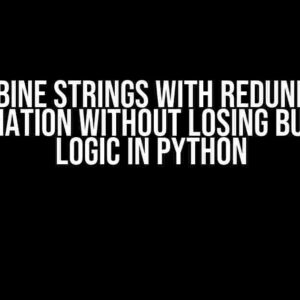In the world of data visualization, dealing with missing datetime data can be a daunting task. However, with the right tools and techniques, you can turn this challenge into an opportunity to create informative and engaging visualizations. Enter axvspan, a powerful matplotlib function that helps you highlight missing datetime data in your plots. In this article, we’ll explore how to harness the power of axvspan to show missing datetime data and take your data visualization skills to the next level.
What is Axvspan?
Axvspan is a matplotlib function that stands for “axis vertical span”. It’s used to create a vertical span across a plot, typically to highlight a specific region of interest. In the context of missing datetime data, axvspan is an ideal tool to draw attention to gaps in your data.
Why Use Axvspan for Missing Datetime Data?
There are several reasons why axvspan is an excellent choice for showing missing datetime data:
- Visual Hierarchy**: Axvspan helps create a clear visual hierarchy in your plot, making it easier for the viewer to focus on the missing data.
- Contextualization**: By highlighting the missing data, you provide context to the viewer, enabling them to better understand the data’s limitations.
- Storytelling**: Axvspan allows you to tell a more comprehensive story with your data, showcasing both the available and missing information.
Preparing Your Data for Axvspan
Before you can use axvspan to show missing datetime data, you need to prepare your data. Here’s a step-by-step guide to get you started:
- Import Libraries**: Import the necessary libraries, including pandas, matplotlib, and numpy.
- Load Your Data**: Load your dataset into a pandas dataframe.
- Convert Datetime Column**: Ensure your datetime column is in a suitable format for plotting.
- Identify Missing Data**: Identify the missing datetime data in your dataset.
import pandas as pd
import matplotlib.pyplot as plt
import numpy as np
# Load your dataset
df = pd.read_csv('your_data.csv')
# Convert datetime column
df['datetime'] = pd.to_datetime(df['datetime'])
# Identify missing data
missing_data = df[df['datetime'].isnull()]
Using Axvspan to Show Missing Datetime Data
Now that your data is prepared, it’s time to use axvspan to highlight the missing datetime data. Here’s an example code snippet to get you started:
# Create a figure and axis
fig, ax = plt.subplots()
# Plot your data
ax.plot(df['datetime'], df['values'])
# Identify the missing datetime ranges
missing_ranges = []
for idx, row in missing_data.iterrows():
missing_ranges.append((row['datetime'], row['datetime']))
# Use axvspan to highlight the missing data
for start, end in missing_ranges:
ax.axvspan(start, end, color='gray', alpha=0.5)
# Show the plot
plt.show()
In this example, we create a line plot of our data using `ax.plot`. Then, we identify the missing datetime ranges using the `missing_data` dataframe. Finally, we use `axvspan` to highlight the missing data ranges, creating a gray vertical span across the plot.
Customizing Axvspan for Better Visualization
Axvspan offers several customization options to enhance the appearance of your plot. Here are a few ways to take your visualization to the next level:
- Color**: Change the color of the axvspan to make it more visible or to match your plot’s color scheme.
- Alpha**: Adjust the transparency of the axvspan to avoid overwhelming the viewer.
- Label**: Add a label to the axvspan to provide additional context.
# Use a different color ax.axvspan(start, end, color='red', alpha=0.5) # Add a label ax.text(start, 0.5, 'Missing Data', ha='center', va='center')
Real-World Applications of Axvspan for Missing Datetime Data
Axvspan is not limited to showing missing datetime data in a single plot. Here are some real-world applications that demonstrate its power:
| Application | Description |
|---|---|
| Financial Analysis | Show gaps in stock market data or missing trading days. |
| Weather Forecasting | Highlight missing temperature or precipitation data in a weather time series. |
| Healthcare | Identify missing patient data or gaps in medical records. |
Conclusion
In conclusion, axvspan is a powerful tool for showing missing datetime data in your plots. By following the steps outlined in this article, you can create informative and engaging visualizations that provide context to your data. Remember to customize axvspan to suit your needs, and don’t be afraid to experiment with different colors, labels, and transparency levels. With axvspan, you’ll be able to unlock new insights from your data and take your data visualization skills to the next level.
So, what are you waiting for? Start using axvspan today and discover the power of effective data visualization!
Frequently Asked Question
Getting lost in the void of missing datetime data? Don’t worry, we’ve got the solution! Here are the top 5 questions and answers on how to use axvspan to show those pesky gaps.
What is axvspan, and how does it help with missing datetime data?
Axvspan is a matplotlib plotting tool that enables you to highlight and visualize gaps in your datetime data. It’s a game-changer for spotting missing values and getting a better understanding of your data’s underlying structure. By using axvspan, you can create a visual representation of your data that showcases the missing datetime values, making it easier to identify and address those pesky gaps.
How do I create an axvspan object to highlight missing datetime data?
To create an axvspan object, you’ll need to import matplotlib.pyplot as plt and define your x-axis data. Then, use the axvspan function, specifying the start and end points of the missing data range. For example: plt.axvspan(start_date, end_date, color='gray', alpha=0.5). This will create a shaded area on your plot, indicating the missing datetime data.
Can I customize the appearance of the axvspan object to better suit my visualization needs?
You bet! The axvspan function offers a range of customization options. You can adjust the color, alpha, and edgecolor to change the appearance of the shaded area. For instance, you can use color='red' to make the missing data stand out more or alpha=0.2 to make the shade more transparent. Experiment with different settings to find the perfect look for your visualization.
How do I integrate axvspan with other visualization tools, like line plots or scatter plots?
The beauty of axvspan lies in its flexibility. You can easily combine it with other visualization tools to create a more comprehensive and informative plot. Simply create your line plot or scatter plot as usual, and then add the axvspan object to highlight the missing datetime data. For example, you can use plt.plot(x, y) to create a line plot and then add plt.axvspan(start_date, end_date, color='gray', alpha=0.5) to highlight the gaps.
What are some common use cases for using axvspan to visualize missing datetime data?
Axvspan is particularly useful in scenarios where data completeness is crucial, such as financial analysis, sensor data monitoring, or weather forecasting. It can also be used to identify patterns or anomalies in data collected over time, like website traffic or user engagement metrics. By visualizing missing datetime data with axvspan, you can gain valuable insights into your data’s underlying structure and make more informed decisions.



